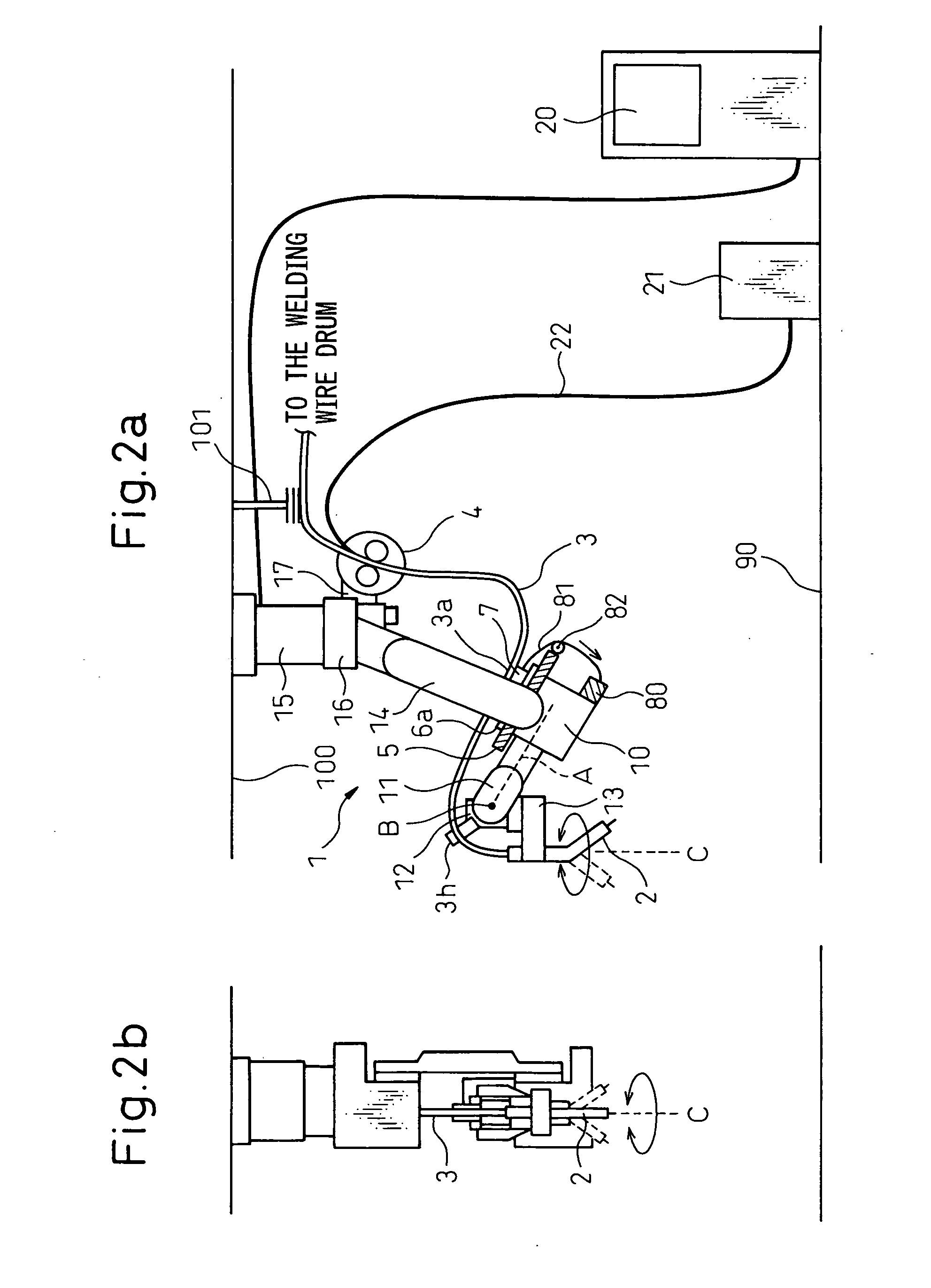Structure for treating torch cable for arc welding robot
- Summary
- Abstract
- Description
- Claims
- Application Information
AI Technical Summary
Benefits of technology
Problems solved by technology
Method used
Image
Examples
first embodiment
[0044] Embodiments of the present invention will be described below with reference to the drawings. FIGS. 2a and 2b illustrate a front view and a right side view, respectively, of an overall structure of an arc welding robot according to the present invention. Reference 1 denotes an arc welding robot of a six-axes type, a robot base 15 of which is installed not on a floor surface 90 but on a ceiling 100 whereby an upper arm 14 extends downward from the robot base 15. At a tip end of a front arm base 10, a first wrist element 11 is provided to be rotatable about a first axis A, and a second wrist element 12 is provided on the first wrist element 11 to be rotatable about a second axis B.
[0045] A welding torch 2 is supported on the second wrist element 12 via a transmission mechanism 13 to be rotatable about a third axis C disposed at a predetermined distance from the first axis A while remaining generally vertical to the second axis B, whereby the welding torch 2 is rotatable about th...
fourth embodiment
[0062]FIGS. 4a and 4b illustrate a front view and a top view, respectively, of an overall structure of an arc welding robot according to the present invention. In this embodiment, a robot base 15 of an arc welding robot 1 is provided in a wall extending upward from a floor surface 90 toward a ceiling 100, and an upper arm 14 extends from the robot base 15 in the lateral direction. At a tip end of a front arm base 10 attached to the vicinity of a tip end of the upper arm 14, a first wrist element 11 is provided to be rotatable about a first axis A, and a second wrist element 12 is provided on the first wrist element 11 to be rotatable about a second axis B.
[0063] A welding torch 2 is supported by the second wrist element 12 via a transmission mechanism 13 (a concrete example thereof will be described later) to be rotatable about a third axis C extending generally vertical to the second axis B and away from the first axis A at a predetermined distance. The welding torch 2 is rotatable...
fifth embodiment
[0073]FIG. 5b illustrates one modification of the In the embodiment shown in FIG. 5b, the slide mechanism is eliminated and, instead, a structure in which an inserting guide 3h is directly provided on a front base 10 is employed. The inserting guide 3h is designed to have a guide hole larger than an outer diameter of the torch cable 3, so that the torch cable 3 freely reciprocates generally parallel to the longitudinal direction of the front arm. Also, as illustrated, a inserting guide 3h′ is also provided on the first wrist element 11 to hold the torch cable 3. Even if the robot wrist shaft operates, the torch cable is maintained in a stable state by these inserting guides 3h and 3h′ while being always along the front arm. As illustrated, the inserting guide 3h is rotatable about a rotary axis on a bearing.
[0074] In the arc welding robot of a wall-hanging type according to this embodiment in which the torch cable is clamped on the slide mechanism, even if the posture of the weldin...
PUM
| Property | Measurement | Unit |
|---|---|---|
| Force | aaaaa | aaaaa |
Abstract
Description
Claims
Application Information
 Login to View More
Login to View More - R&D
- Intellectual Property
- Life Sciences
- Materials
- Tech Scout
- Unparalleled Data Quality
- Higher Quality Content
- 60% Fewer Hallucinations
Browse by: Latest US Patents, China's latest patents, Technical Efficacy Thesaurus, Application Domain, Technology Topic, Popular Technical Reports.
© 2025 PatSnap. All rights reserved.Legal|Privacy policy|Modern Slavery Act Transparency Statement|Sitemap|About US| Contact US: help@patsnap.com



